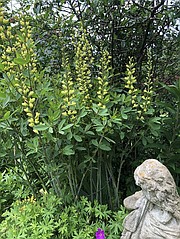MAY
April was a bit kinder to us than March. We have finally had some glorious weather, and with all the extra time some gardeners have these days, our gardens are looking the best they ever have.
We can all hope that the cold is behind us. We had some fairly cool nights in April with a few light frosts -- and a few extremely hot days -- but overall, it was pleasant.
By now, all of your plants should have new growth showing, and you can begin to assess winter damage and correct it. Now is also a great time for planting everything from flowers and vegetables to shrubs and tropical flowers.
• Many gardeners are complaining about misshapen leaves on gardenias, figs and a few other moderately hardy plants. This is a result of the recent cold. Newly emerging leaves were frozen or damaged, and the tissue did not fully form. The new foliage that appears from now on should be fine. There is nothing you can do about it anyway. If you have buds sprouting farther down the stem, prune out damaged branches.
• We have seen dieback on hydrangeas, figs, some gardenias, "Soft Caress" mahonia and some palms. If you have plants that have seen better days, dig them up and plant something new. There are so many options out there.
• Vegetable gardening is at an all-time high. The prospect of fresh, home-grown vegetables is on many minds. Vegetable transplants are being bought in record numbers, so shoppers have noticed some of their favorite varieties missing. Try something new but keep checking back because greenhouses and garden centers do replenish plants.
• This is the perfect time to plant summer squash, peppers, eggplants, tomatoes, watermelon, cantaloupe, cucumbers, southern peas and okra. Transplants are used for tomatoes, peppers and eggplants but you can seed the rest. If space is limited, consider trellising the vining space-hogging plants like cucumber, watermelons and cantaloupes.
• The cool, moist spring has brought with it a few diseases. Many azaleas and camellias have thickened, distorted leaves caused by a fungus called azalea or camellia leaf gall. The disease looks much worse than it is. If you see deformed new foliage, prune it out and dispose of it. Now that the weather is warming up, the new foliage should be normal in appearance. We also have seen some anthracnose disease on some maples and sycamores. The damaged leaves will shed, but again, with warmer weather, we should see a rebound of new, healthy growth. No sprays are needed for any of these problems at this time.
• If you have apples or pears, be on the lookout in the next few weeks for signs of fire blight. Fire blight is a bacterial disease that is transmitted by bees when they pollinate the blooms. This disease is also worse in a cool, wet spring so I expect to see a lot of it. The disease can affect a wide variety of plants but is most commonly seen on apples and pears -- both edible and ornamental varieties. The disease gets the name "fire blight" because the tips of the branches appear to be burned or scorched, and usually have a shepherd's crook appearance. Sprays are only slightly effective and must be applied before the plants finish flowering. For now, if you see it, just prune it out 8 inches beneath where visible symptoms appear.
• Lawn grasses have totally greened up almost statewide. If you have winter weeds, they are on their way out and summer weeds have started their attack. Now is a great time to apply an application of a high nitrogen fertilizer. Remember, don't get heavy-handed with fertilizer or you could burn the lawn.
• If your deck or patio -- or even your general landscape -- could use some heat-loving color, look at tropical flowers. There are so many options in size, color and type of plant. Every year we have more and more options. While most are sun-loving, there are a few that will do well in the shade. Houseplants are tropical plants, and most of them will thrive outside in the shade all summer. They can give you some different forms and textures, even mixed in with your normal landscape plants.
• The gardening season is in high gear, and it won't be long before insects and diseases will add to the host of weeds that plague us. Walk your garden regularly, and if you see problems, take pictures and email your county agents or local nurseries for proper diagnoses. The longer a problem goes undetected, the bigger the problem will become.
BAPTISIA -- FALSE INDIGO
There are several varieties of Baptisia or false indigo, a native perennial member of the bean family that can be found statewide in Arkansas.
Depending on the variety, the spikes of pea-like blooms can be white, pale yellow, purple or bright yellow in their native colors. With new introductions, the color palette has widened to include bi-colored blooms in shades of red, mauve, deep purple and lemon yellow.
Some varieties start blooming in late April and can continue through early June.
Baptisias grow in most soil types provided they are well drained, and the plants do well in full sun to partial shade.
Plants can grow from 2 to 5 feet tall, depending on variety, and each year the clump will expand in width.
After flowering, bean-like seed pods will form, which will often persist into the winter months. Once established, the plant is very drought tolerant, and the plants are considered deer resistant.
Janet Carson's blog is at arkansasonline.com/planitjanet.
HomeStyle on 05/02/2020

